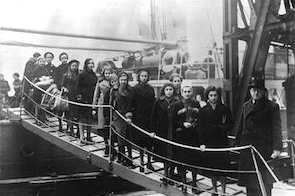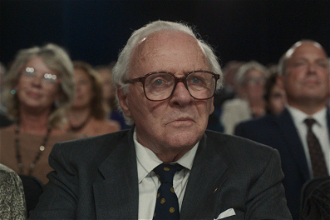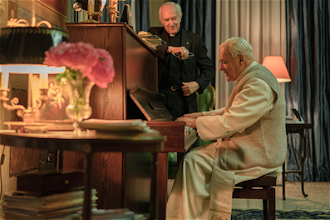Film: Noah

Fr Peter Malone, from Signis (the World Catholic Association for Communication) comments on Darren Aronofsky's new film Noah, starring Russell Crowe in the title role, Anthony Hopkins as Methuselah, Ray Winstone, Emma Watson, Jennifer Connelly and Logan Lerman.
Noah has been produced as a big budget entertainment movie for world release. It is not a documentary, and it is not a visual aid to study of the book of Genesis. It is the brain-child of writer-director, Darren Aronofsky. Commentators note that his dramas are preoccupied with a range of obsessives, Pi, Requiem for a Dream, The Wrestler, The Black Swan. Noah joins their obsessive company.
The film is divided into two parts: the establishment of the character of Noah and his family, his sense of mission, the building of the Ark. This part plays very much like an epic movie, or one of those Marvel Comics movies. The second part has the family on the Ark, focuses on the character of Noah, especially his interior life, his doubts, his
questioning of his mission. The way the film is written and performed may remind audiences of Greek tragedy, or of Noah being something like a King Lear. The popular audience will appreciate the first part of the film but might find the second part hard going. A more thoughtful audience will probably appreciate the second part, possibly wanting to forget the first part.
Religious audiences will immediately realise that God is not mentioned at all in the film. Rather, the makers have opted to use the term, The Creator. In fact, this alternative to God, works particularly well, reminiscent of the creation accounts and emphasising The Creator’s intentions in making the world and all living things, including humankind. This leads to what could be called a subtext about creation, the environment, and ecological message. But, throughout the film, it is alluded to so often, and then made explicit, that it becomes something of an instruction about care for the world.
On the other hand, The Creator, according to Noah’s experiences, is The Destroyer. There is an interesting section of the film when Noah and family begin their Ark journey. Noah recites the key Genesis 1 text of the days of creation and there are visuals to illustrate each of them, a sequence that is very effective.
Noah has an enemy, Tubal-Cain, who has killed his father and defies Noah, offering another variation on the Genesis theme, when Tubal-Cain stows away on the Ark. He is given a speech, using the old translations of Genesis 1, about the role of humans to subdue creation. He upholds old values of domination rather than respect for creation and the environment.
A particular difficulty is the variation on the Genesis text about the three sons of Noah taking their wives on board. This time only Shem has a wife, the rescued orphan girl. Noah has become so obsessed by this time that he threatens to kill the child if she is a girl and predicts that, if it is a boy, he will be the last of the humans to die. Ham has gone amongst the people to seek a wife to take on to the Ark, but is thwarted by his father, later resenting him (and giving support to the stowaway, Tubal-Cain). This means that the film raises the question of how the human race is to continue, the same question that is implicit in the story of Cain, Seth and their descendants and how children came to be.
This gives people the opportunity to discuss the Noah and Deluge story, what it meant in the times that the saga was created and handed on by word of mouth and finally written down, to discuss the religious and theological meaning of the Flood story as part of the basic relationship between God and humans.
As regards the film itself, the locations have the look of the prehistoric, pre-apocalyptic (or post-apocalyptic for those fond of the many movies about dystopian societies are wars of destruction) and were filmed in the various terrains of Iceland. They are both interesting and exotic. The film also relies on computergraphics, especially for the animals assembling and going into the Ark, the flights of birds first, then the procession of animals, all computer-generated. Noah’s wife is able to induce hibernation by swirling a kind of incense.
While the film makers actually built an Ark, using the specifications in the book of Genesis, the flood and the sea of waters are also computer-generated. As, of course, are the Watchers, their building of the Ark, their defence against the enemies, the battle sequences and their ascension to the skies, experiencing their own distinctive Rapture.
The sequence in the book of Genesis, chapter 9, where Noah drinks of the wines that have been cultivated and lies naked, drunk, and his sons respectfully move backwards to cover him, is included in this film, but immediately after the waters subside. Noah is still in confusion about his mission his behaviour and becomes drunk, with his sons covering him as described in the Bible.
The production design and the costume designers have opted for quite anachronistic choices, manufactured material, metal buckets and pipes, armour and weapons. And the choice for clothing looks a variation on the modern, a denim and leather look and something of an ancient T-shirt culture.
Russell Crowe gives a very dignified performance as Noah and Jennifer Connelly has dignity, looyalty and patience as his wife. On the other hand, Anthony Hopkins gives only a slight variation on his Welsh-accented genial performance as Methuselah. Ray Winstone, a little more subdued than usual, is a vicious Tubal-Cain. Emma Watson, post-Harry Potter, is the orphan girl. Most of the principal cast are not Americans and it is interesting to note that Jennifer Connelly and Logan Lerman as Ham use a more English accent.
Some audiences may think the film a winds down in the second half concentrating as it does on Noah, his interior life, his questioning of the commission, his relentless understanding of The Creator’s intentions for destroying the world and wanting to remain faithful. This makes him something of a tragic figure, his growing older, less certain, mentally disturbed, crazed even to wanting to destroy his son’s child. He is like a tragedy figure, with a tragic flaw which will destroy him and those around him. As mentioned, it is something like a variation on King Lear.
The film-makers have counted on this being a commercial success. Religious audiences may well be interested, interpreting the story according to their beliefs. Audiences who have little interest in religion may not want to see the film, although they will support its environmental message and may judge Noah as being deluded by voices, a fundamentalist believer that this is God’s reveleation. And with its striking differences between each part, word-of-mouth may well be cautious.
Noah is an entertainment, one might say of biblical proportions. But it is not a film that would be compulsory for students of the Bible.
The Christian charity Damaris Trust is offering free Noah resources, including a booklet and DVD clips for use by church and community groups. For more information see: www.damaris.org/noah


















